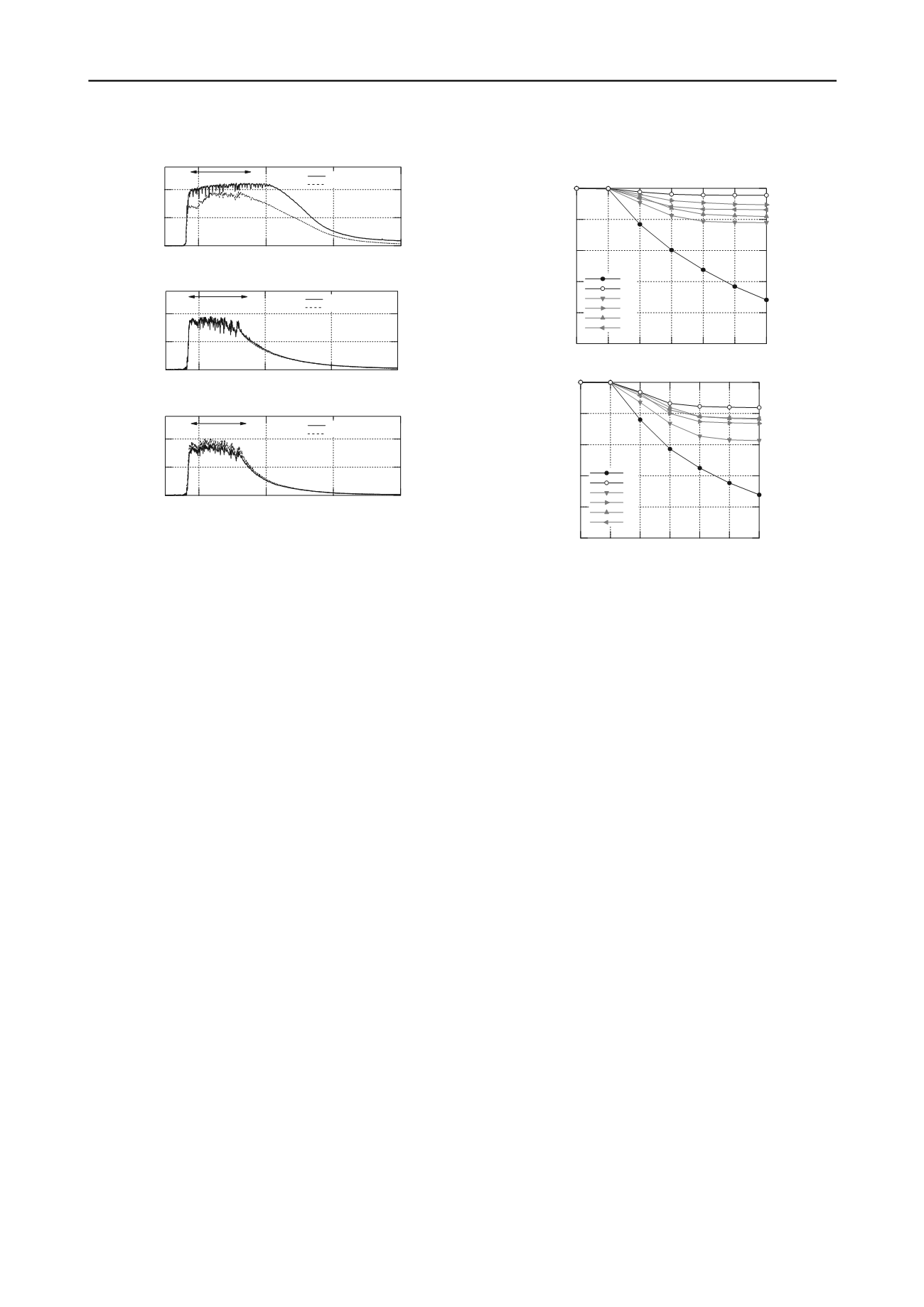
1622
Proceedings of the 18
th
International Conference on Soil Mechanics and Geotechnical Engineering, Paris 2013
the principal motion. This behaviour indicated that the ground
was not fully liquefied although the excess pore water pressure
was generated. Similar tendency was observed in B2, the
floating-type improvement case, and the ground in B2 was not
also liquefied. It followed that the floating-type improvement as
well as the fixed-type one took effect, restricting excess pore
water pressure in a liquefiable sandy layer.
3.3.2
Ground settlement
Figure 9 presents the cumulative ground settlement in Series B
in a proto-type scale. Each figure represents the settlement at
the top of the lattice-shaped mold and the ground surface inside
the grid, respectively. The horizontal axis shows the number of
stepwise shaking.
The ground settlement of B1, the unimprovement case,
reached 0.23 m in Step 2 and increased every step. The final
settlement was 0.72 m in Step 6. This large value was due to the
liquefaction of ground in every step. In the meanwhile, the
settlements of B2, the fixed-type improvement case, were 0.02
m at the top of the mold and 0.06 m at the ground surface. The
large settlement could not be found in the successive shaking
steps due to no liquefaction.
As for B3 ~ B6, the floating-type improvement cases, the
settlements were a little larger than those of B2 in each shaking
step. However, the settlements of B3 ~ B6 were much smaller
than those of B1, and the improvement effect of the floating-
type was confirmed in terms of ground settlement. Especially,
the settlement of B1 increased in every step, and ones of B3 ~
B6, meanwhile, did not increase. Therefore, the floating-type as
well as the fixed-type was found to be effective against the
ground settlement by liquefaction.
4 CONCLUSIONS
This paper examined the countermeasure effect of the floating-
type and lattice-shaped cement treatment method by using the
numerical analyses and the centrifuge model tests. The main
mechanism of this method as a liquefaction countermeasure was
that the floating-type treated soil reduced the shear stress that
was generated in the stratum between treated soil and
unliquefiable stratum. This effectiveness was confirmed by the
one-dimensional numerical analyses. The centrifuge model tests
resulted that the synchronism of the floating-type treated soil
and the unliquefiable stratum could restrict the generation of
excess pore water pressure the in-between stratum as well as the
unimproved soil inside the girds. In addition, the floating-type
improvement was found to decrease the ground settlement, and
the improvement effect became larger by deepening the depth
of the floating-type treated soil.
1.0
0.5
0.0
E.P.W.P.
u/
'
200
150
100
50
Time (sec)
Major strong motion
G.L.-3.5m (Pwp1)
G.L.-7.0m (Pwp2)
1.0
0.5
0.0
E.P.W.P.
u/
'
200
150
100
50
Time (sec)
Major strong motion
G.L.-3.5m (Pwp1)
G.L.-7.0m (Pwp2)
1.0
0.5
0.0
E.P.W.P.
u/
'
200
150
100
50
Time (sec)
Major strong motion
G.L.-3.5m (Pwp1)
G.L.-7.0m (Pwp2)
Figure 8. Time histories of excess pore water pressure at Pwp1 and
Pwp2: upper; unimprovement case (B1), middle; fixed-type
improvement case (B2), floating-type improvement case (B4)
1.0
0.8
0.6
0.4
0.2
0.0
Ground settlement (m)
6 5 4 3 2 1 0
Shaking step No.
B1
B2
B3
B4
B5
B6
1.0
0.8
0.6
0.4
0.2
0.0
Ground settlement (m)
6 5 4 3 2 1 0
Shaking step No.
B1
B2
B3
B4
B5
B6
Figure 9. Cumulative ground settlement: upper; top of lattice-shaped
mold at Dp1, lower; top of ground surface inside grid at Dp2
ACKNOWLEDGEMENTS
A part of this research was conducted within the collaborative
project of Port and Airport Research Institute, Penta Ocean
Construction Co., Shimizu Co., Takenaka Civil Engineering &
Construction Co., Toa Co., Toyo Co., and Fudo Tetra Co. The
authors are very grateful for their valuable cooperation in our
work.
REFERENCES
Kitazume M. and Miyajima S. 1995. Development of PHRI Mark II
geotechnical centrifuge.
Technical Note of the Port and Harbour
Research Institute
(817), 1-33.
Okamura M. and Inoue T. 2012. Preparation of fully saturated models
for liquefaction study.
International Journal of Physical Modelling
in Geotechnics
12(1), 39-46.
Takahashi H., Kitazume M. and Ishibashi S. 2006a. Effect of deep
mixing wall spacing on liquefaction mitigation.
Proceedings of the
International Conference on Physical Modelling in Geotechnics
1,
585-590.
Takahashi H., Kitazume M., Ishibashi S. and Yamawaki S. 2006b.
Evaluating the saturation of model ground by P-wave velocity and
modeling of models for a liquefaction study.
International Journal
of Physical Modelling in Geotechnics
6(1), 13-25.
Takahashi H., Yamawaki S., Kitazume M. and Ishibashi S. 2006c.
Effects of deep mixing method on liquefaction prevention and
proposal on new arrangement of grid-type improvement.
Report of
the Port and Airport Research Institute
45(2), 135-167. (in
Japanese)


